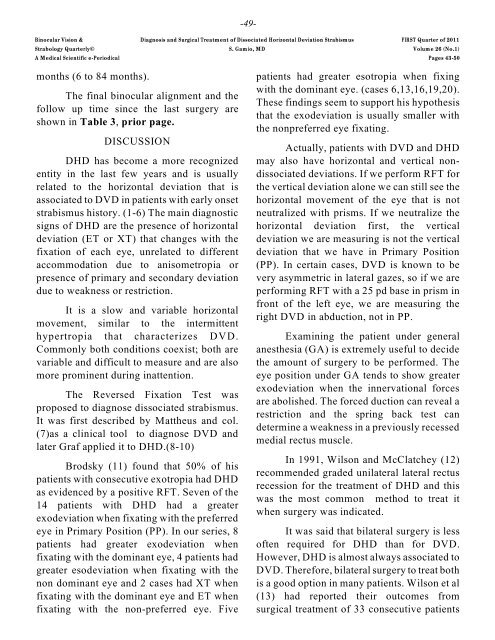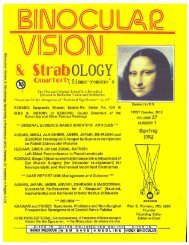Correspondence - ICO Library
Correspondence - ICO Library
Correspondence - ICO Library
Create successful ePaper yourself
Turn your PDF publications into a flip-book with our unique Google optimized e-Paper software.
-49-<br />
Binocular Vision & Diagnosis and Surgical Treatm ent of Dissociated Horizontal Deviation Strabism us FIRST Quarter of 2011<br />
Strabology Quarterly© S. Gam io, M D Volum e 26 (No.1)<br />
A M edical Scientific e-Periodical Pages 43-50<br />
months (6 to 84 months).<br />
The final binocular alignment and the<br />
follow up time since the last surgery are<br />
shown in Table 3, prior page.<br />
DISCUSSION<br />
DHD has become a more recognized<br />
entity in the last few years and is usually<br />
related to the horizontal deviation that is<br />
associated to DVD in patients with early onset<br />
strabismus history. (1-6) The main diagnostic<br />
signs of DHD are the presence of horizontal<br />
deviation (ET or XT) that changes with the<br />
fixation of each eye, unrelated to different<br />
accommodation due to anisometropia or<br />
presence of primary and secondary deviation<br />
due to weakness or restriction.<br />
It is a slow and variable horizontal<br />
movement, similar to the intermittent<br />
hypertropia that characterizes DVD.<br />
Commonly both conditions coexist; both are<br />
variable and difficult to measure and are also<br />
more prominent during inattention.<br />
The Reversed Fixation Test was<br />
proposed to diagnose dissociated strabismus.<br />
It was first described by Mattheus and col.<br />
(7)as a clinical tool to diagnose DVD and<br />
later Graf applied it to DHD.(8-10)<br />
Brodsky (11) found that 50% of his<br />
patients with consecutive exotropia had DHD<br />
as evidenced by a positive RFT. Seven of the<br />
14 patients with DHD had a greater<br />
exodeviation when fixating with the preferred<br />
eye in Primary Position (PP). In our series, 8<br />
patients had greater exodeviation when<br />
fixating with the dominant eye, 4 patients had<br />
greater esodeviation when fixating with the<br />
non dominant eye and 2 cases had XT when<br />
fixating with the dominant eye and ET when<br />
fixating with the non-preferred eye. Five<br />
patients had greater esotropia when fixing<br />
with the dominant eye. (cases 6,13,16,19,20).<br />
These findings seem to support his hypothesis<br />
that the exodeviation is usually smaller with<br />
the nonpreferred eye fixating.<br />
Actually, patients with DVD and DHD<br />
may also have horizontal and vertical nondissociated<br />
deviations. If we perform RFT for<br />
the vertical deviation alone we can still see the<br />
horizontal movement of the eye that is not<br />
neutralized with prisms. If we neutralize the<br />
horizontal deviation first, the vertical<br />
deviation we are measuring is not the vertical<br />
deviation that we have in Primary Position<br />
(PP). In certain cases, DVD is known to be<br />
very asymmetric in lateral gazes, so if we are<br />
performing RFT with a 25 pd base in prism in<br />
front of the left eye, we are measuring the<br />
right DVD in abduction, not in PP.<br />
Examining the patient under general<br />
anesthesia (GA) is extremely useful to decide<br />
the amount of surgery to be performed. The<br />
eye position under GA tends to show greater<br />
exodeviation when the innervational forces<br />
are abolished. The forced duction can reveal a<br />
restriction and the spring back test can<br />
determine a weakness in a previously recessed<br />
medial rectus muscle.<br />
In 1991, Wilson and McClatchey (12)<br />
recommended graded unilateral lateral rectus<br />
recession for the treatment of DHD and this<br />
was the most common method to treat it<br />
when surgery was indicated.<br />
It was said that bilateral surgery is less<br />
often required for DHD than for DVD.<br />
However, DHD is almost always associated to<br />
DVD. Therefore, bilateral surgery to treat both<br />
is a good option in many patients. Wilson et al<br />
(13) had reported their outcomes from<br />
surgical treatment of 33 consecutive patients









